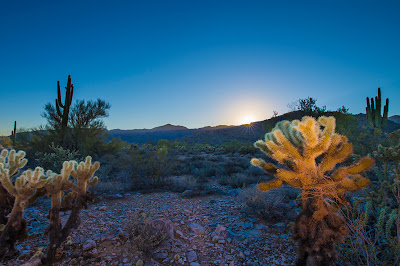Almost Sunset
Nearly 30,000 acres makes this the largest regional park in Maricopa County. Most of the park is made up of the rugged and beautiful White Tank Mountains on the Valleys west side. The range, deeply serrated with ridges and canyons, rises sharply from its base to peak at over 4,000 feet. Infrequent heavy rains cause flash floodwaters to plunge through the canyons and pour onto the plain. These torrential flows, pouring down chutes and dropping off ledges, have scoured out a series of depressions, or tanks, in the white granite rock below, thus giving the mountains their name.
Ancient Arizonans pecked hundreds of figures and
symbols on the rock faces of the White Tank Mountains. Some may approach 10,000
years old. All have withstood sun, rain, and vandals for 700 or 800 years or
more.
Eleven archaeological sites, occupied during the time period A.D.
500-1100, were located within the boundaries of White Tank Mountain Regional
Park. All of these sites can be attributed to the Hohokam Indians. The White
Tanks were apparently abandoned by the Hohokam about A.D. 1100. There is no
further indication of human occupation until the historic period, when the
Western Yavapai controlled the area. Due to the ruggedness of the terrain and
the difficulty of obtaining water, sites in the White Tank Mountains were
restricted to large canyons leading out of the mountains on the east, north and
probably west.
A rock drawing was serious business to its maker.
While no one can say precisely what most of them "mean", we know they had
important functions in the lives of their makers. They were not simply
stone-age graffiti. The symbols recorded events and marked locations. They were
a magical way to control nature so rain would fall or mountain sheep would let
themselves be caught. Some served as trail markers and maps. Others represented
religious concepts.
Most of the sites in the area are concentrated around the White Tanks themselves. The Tanks probably held water the year-round and thereby drew people to the region. Petroglyphs on rocks indicate the Indians were more than transients. Pottery shards along the Agua Fria and Hassayampa signify the presence of villages and a good possibility that an Indian trail connected the streams with the White Tank long before Europeans came into the area. The discovery of possible agricultural terraces or check dams indicates that farming may have been carried on in the various canyons of the White Tank Mountains, by utilizing seasonal runoff and rain water.
Verbiage Courtesy Maricopa.gov







No comments:
Post a Comment